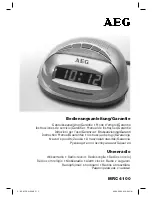
5
Bosch | 6/04 | 32029E
5.0 Periodic Testing
Calibration is very important in determining the
detector’s continued operation. Depending on local
regulations, the frequency of calibration testing might be
required more often than once a year. NFPA 72
recommends calibration tests be made at installation,
and then every other year. Perform a Functional Test
annually.
Notify all concerned parties before and after
any maintenance or testing of the fire alarm
system.
To meet the NFPA 72 requirement, check calibration
using any of the tests described in Section 5.1 Visual
Check through Section 5.4 Thermistor Test. These tests
confirm whether or not the detector is within its factory
marked calibration range.
5.1 Visual Check
This detector includes the Chamber Check Automatic
Trouble Indication allowing it to automatically indicate
when its calibration is out of the factory listed range. A
visual check allows you to meet the NFPA guidelines
for sensitivity testing by inspecting the detector and
checking the flash rate of the LED.
If the calibration is out of range for more than 24 h, the
detector’s alarm LED begins flashing once per second.
The LED flashes once every 3 sec when the detector is
operating normally.
Visually check all detectors before resetting the power.
Disconnecting the detector power erases this indication.
If the detector was reset within the last 24 h, or you are
unsure of the last reset time, perform a Magnet Test or
Voltage Measurement Test to confirm the sensitivity.
5.2 Magnet Test
Place a magnet horizontally against the detector,
centered over the “T” marked on the head. Observe the
LED.
•
If the detector is within the factory marked
calibration range, it goes into alarm and the alarm
LED latches ON.
•
If the detector is too sensitive, the LED rapidly
flashes six times (once every 1/2 sec) and the detector
goes into alarm.
•
If the detector is not sensitive enough, the LED
flashes four times slowly (once every 2 sec) and the
detector goes into alarm.
•
If the detector is not operational, it does not signal an
alarm.
Figure 4:
Calibration Voltage Pins
1 - Calibration voltage pins
1
D285/D285TH
| Installation Instructions | 5.0 Periodic Testing
5.3 Voltage Measurement Test
1.
Plug a D1005 Test Cable (optional) into the
calibration voltage pins (refer to Figure 4).
2. Connect a digital voltmeter to the D1005 Test
Cable.
3. Connect the meter’s negative terminal to the
D1005’s black wire; and connect the meter’s
positive terminal to the test cable’s red wire. The
D1005’s white wire is not used.
a.
The voltage measured by the voltmeter is 1/2
the sensitivity (in %/ft obscuration) of the
detector.
b.
Multiply the voltage by 2. The result should
be within the factory marked calibration
range printed on the label that is attached to
the bottom of the detector.
4. If the detector is outside of the factory marked
calibration range, remove it and clean is as
described in Section 4.0 Maintenance on page 4.
5. Recheck the calibration voltage measurement.
If the detector is still outside the factory marked
calibration range after cleaning, return the unit to
Bosch for re-calibration.
5.4 Thermistor Test
Expose the thermistor to a heat source (such as a hair
dryer or a shielded heat lamp) until the detector goes
into alarm and the alarm LED latches on. If the unit
does not go into alarm, return it to Bosch for repair.
Before proceeding to the next detector, clear
each test alarm.


























